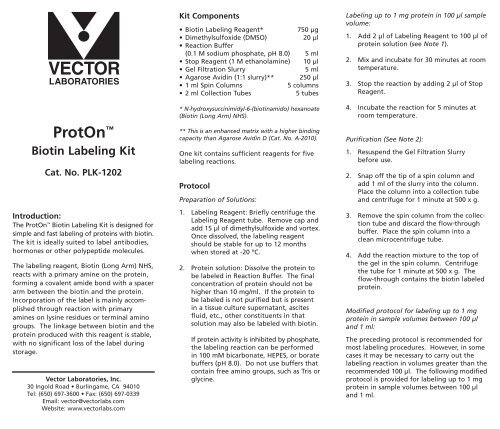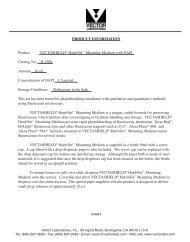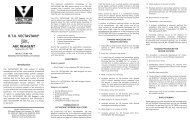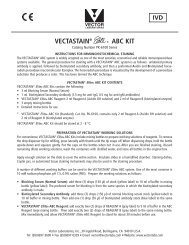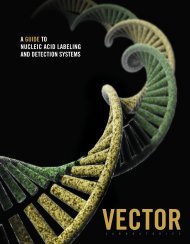ProtOn⢠Biotin Labeling Kit - Vector Laboratories
ProtOn⢠Biotin Labeling Kit - Vector Laboratories
ProtOn⢠Biotin Labeling Kit - Vector Laboratories
You also want an ePaper? Increase the reach of your titles
YUMPU automatically turns print PDFs into web optimized ePapers that Google loves.
VECTORLABORATORIESProtOn <strong>Biotin</strong> <strong>Labeling</strong> <strong>Kit</strong>Cat. No. PLK-1202Introduction:The ProtOn <strong>Biotin</strong> <strong>Labeling</strong> <strong>Kit</strong> is designed forsimple and fast labeling of proteins with biotin.The kit is ideally suited to label antibodies,hormones or other polypeptide molecules.The labeling reagent, <strong>Biotin</strong> (Long Arm) NHS,reacts with a primary amine on the protein,forming a covalent amide bond with a spacerarm between the biotin and the protein.Incorporation of the label is mainly accomplishedthrough reaction with primaryamines on lysine residues or terminal aminogroups. The linkage between biotin and theprotein produced with this reagent is stable,with no significant loss of the label duringstorage.<strong>Vector</strong> <strong>Laboratories</strong>, Inc.30 Ingold Road • Burlingame, CA 94010Tel: (650) 697-3600 • Fax: (650) 697-0339Email: vector@vectorlabs.comWebsite: www.vectorlabs.com<strong>Kit</strong> Components• <strong>Biotin</strong> <strong>Labeling</strong> Reagent* 750 µg• Dimethylsulfoxide (DMSO) 20 µl• Reaction Buffer(0.1 M sodium phosphate, pH 8.0) 5 ml• Stop Reagent (1 M ethanolamine) 10 µl• Gel Filtration Slurry5 ml• Agarose Avidin (1:1 slurry)** 250 µl• 1 ml Spin Columns5 columns• 2 ml Collection Tubes5 tubes* N-hydroxysuccinimidyl-6-(biotinamido) hexanoate(<strong>Biotin</strong> (Long Arm) NHS).** This is an enhanced matrix with a higher bindingcapacity than Agarose Avidin D (Cat. No. A-2010).One kit contains sufficient reagents for fivelabeling reactions.ProtocolPreparation of Solutions:1. <strong>Labeling</strong> Reagent: Briefly centrifuge the<strong>Labeling</strong> Reagent tube. Remove cap andadd 15 µl of dimethylsulfoxide and vortex.Once dissolved, the labeling reagentshould be stable for up to 12 monthswhen stored at -20 ºC.2. Protein solution: Dissolve the protein tobe labeled in Reaction Buffer. The finalconcentration of protein should not behigher than 10 mg/ml. If the protein tobe labeled is not purified but is presentin a tissue culture supernatant, ascitesfluid, etc., other constituents in thatsolution may also be labeled with biotin.If protein activity is inhibited by phosphate,the labeling reaction can be performedin 100 mM bicarbonate, HEPES, or boratebuffers (pH 8.0). Do not use buffers thatcontain free amino groups, such as Tris orglycine.<strong>Labeling</strong> up to 1 mg protein in 100 µl samplevolume:1. Add 2 µl of <strong>Labeling</strong> Reagent to 100 µl ofprotein solution (see Note 1).2. Mix and incubate for 30 minutes at roomtemperature.3. Stop the reaction by adding 2 µl of StopReagent.4. Incubate the reaction for 5 minutes atroom temperature.Purification (See Note 2):1. Resuspend the Gel Filtration Slurrybefore use.2. Snap off the tip of a spin column andadd 1 ml of the slurry into the column.Place the column into a collection tubeand centrifuge for 1 minute at 500 x g.3. Remove the spin column from the collectiontube and discard the flow-throughbuffer. Place the spin column into aclean microcentrifuge tube.4. Add the reaction mixture to the top ofthe gel in the spin column. Centrifugethe tube for 1 minute at 500 x g. Theflow-through contains the biotin labeledprotein.Modified protocol for labeling up to 1 mgprotein in sample volumes between 100 µland 1 ml:The preceding protocol is recommended formost labeling procedures. However, in somecases it may be necessary to carry out thelabeling reaction in volumes greater than therecommended 100 µl. The following modifiedprotocol is provided for labeling up to 1 mgprotein in sample volumes between 100 µland 1 ml.
1. Add 2 µl of <strong>Labeling</strong> Reagent (see Note 1)to up to 1 ml of protein sample in appropriatebuffer (see “Preparation of ProteinSolution”).2. Mix and incubate for 2 hours at roomtemperature.3. Stop the reaction by adding 2 µl of StopReagent.4. Incubate the reaction for 5 minutes atroom temperature.5. Remove excess labeling reagent bydialyzing the sample against 2 liters ofappropriate buffer for 3 hours toovernight. (Use of spin columns isrecommended only for reaction volumesof 100 µl - 120 µl.)Notes:Note 1) The optimal extent of biotin labelingof the protein will depend on the intendedapplication. The concentration of <strong>Labeling</strong>Reagent used in this step is generally recommendedfor labeling most proteins, includingimmunoglobulins. However, since the numberof available primary amino groups differsbetween proteins, the amount of labelingReagent used may require optimization forindividual applications. (See “Estimation ofPercent <strong>Biotin</strong>ylation”.)Note 2) A spin column is a fast and convenientpurification method. However, for applicationsthat may be affected by trace amounts offree biotin, or for proteins smaller than 25 kDa,purification can be accomplished by dialyzingthe solution against 2 liters of PBS (10 mMsodium phosphate, 150 mM NaCI, pH 7.5) orother appropriate buffer for 3 hours toovernight.Estimation of Percent <strong>Biotin</strong>ylationWith an adequate amount of protein, thepercent of all protein molecules containingbiotins accessible to avidin can be determinedby passing an aliquot of the purifiedlabeled protein through Agarose Avidin andmeasuring the percentage of the proteinsample bound to Agarose Avidin (based onO.D. 280 nm).With smaller amounts of protein, theamount of sample required for accuratedetermination with this test generally precludesits use. However, the percent biotinylationof these samples can be approximated usingthe following test:1. To 5-10 µl of labeled protein sample (at1 mg/ml) in a microcentrifuge tube, add50 µl of the resuspended Agarose Avidinslurry.2. Incubate for 30 minutes, occasionallyresuspending gently with a pipet tip. Toprevent Agarose Avidin from adhering tothe wall of the tube above the meniscus,do not vortex or mix vigorously.3. Spin down the slurry by centrifuging for2 minutes at 500 x g.4. Carefully collect the supernatant withoutdisturbing the settled Agarose Avidin.The supernatant contains unbiotinylatedproteins (Solution A).5. Add 50 µl of buffer to another aliquot ofthe labeled protein sample (Solution B).6. Load serially diluted aliquots ofSolution A and Solution B on an SDS-PAGE gel. After electrophoresis, stain thegel using a protein stain. The percentbiotinylation can be approximated bycomparing the relative intensities of thebands before and after incubation withAgarose Avidin. A successful labelingreaction should contain only a minorfraction of the protein band in Solution A.The efficiency of biotinylation can also bechecked using one of the following tests:Test 1Serially dilute an aliquot of the biotinylatedprotein. Similarly, make serial dilutions of aknown biotinylated reference standard (e.g.biotinylated mouse IgG, Cat. No. BI-1003)over the same concentration range as thebiotinylated protein. Dot these dilutedsamples onto a nitrocellulose membrane ina side-by-side fashion and compare the signalintensity of the dots after visualization with astreptavidin- or avidin-based detection system.Test 2If the protein has biological or enzymaticactivity that is not affected by biotinylation,that activity can be used to estimate percentbiotinylation.Use the Agarose Avidin to remove biotinylatedprotein from solution, as described in Steps 1-6above. Measure the enzymatic or biologicalactivity in the supernatant. The percentbiotinylation can be estimated by comparingthe activity of the protein in the supernatant(A) with the activity of the proteinbefore labeling (B) at the same concentration,using the following formula:percent biotinylation = B - A X 100BTest 3To accurately determine the total number ofbiotins per protein, we recommend usingthe Quant*Tag <strong>Biotin</strong> Quantitation <strong>Kit</strong>(Cat. No. BDK-2000).VECTORLABORATORIESFor a comprehensive catalog of antibodies andother immunohistochemical products pleasephone or visit our website:www.vectorlabs.comThe ProtOn <strong>Biotin</strong> <strong>Labeling</strong> <strong>Kit</strong> is designed to beused for laboratory use only.©VECTOR LABORATORIES, INC. 2009 PLK-BIO-3


